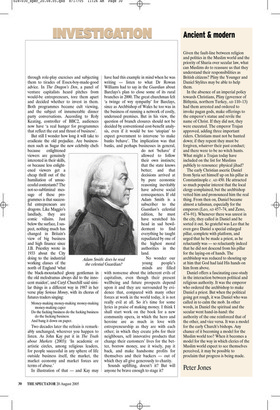Ancient & modern
Given the fault-line between religion and politics in the Muslim world and the priority of Sharia over secular law, what can Muslims do to reassure us that they understand their responsibilities as British citizens? Pliny the Younger and Daniel Stylites may be able to help them.
In the absence of an imperial policy towards Christians, Pliny (governor of Bithynia, northern Turkey, AD 110–13) had them arrested and ordered to invoke pagan gods, make offerings to the emperor’s statue and revile the name of Christ. If they did not, they were executed. The emperor Trajan approved, adding three important riders. Christians must not be hunted down; if they repent they must be forgiven, whatever their past conduct; and there were to be no witch hunts. What might a Trajan today have included on the list for Muslims publicly to renounce: physical jihad?
The early Christian ascetic Daniel from Syria set himself up on his pillar in Constantinople c. AD 450. He attracted so much popular interest that the local clergy complained, but the archbishop vetted him and pronounced him the real thing. From then on, Daniel became almost a talisman, especially for the emperors (Leo, AD 457–74, and Zeno, 474–91). Whenever there was unrest in the city, they called in Daniel and he sorted it out. So grateful was Leo that he even gave Daniel a special enlarged pillar, complete with platform, and urged that he be made a priest, as he reluctantly was — so reluctantly indeed that he did not descend from his pillar for the laying-on of hands. The archbishop was reduced to shouting up at him that God had laid His hands on him from above.
Daniel offers a fascinating case-study in the interaction between political and religious authority. It was the emperor who ordered the archbishop to make Daniel a priest. But when the political going got rough, it was Daniel who was called in to calm the mob. In other words, in Daniel the spiritual and the secular went hand-in-hand: the authority of the one reinforced that of the other, and vice versa. It was a model for the early Church’s bishops. Any chance of it becoming a model for the Muslim world too? When it becomes a model for the way in which clerics of the Muslim world expect to see themselves perceived, it may be possible to proclaim that progress is being made.
Peter Jones

















































 Previous page
Previous page